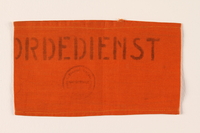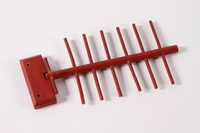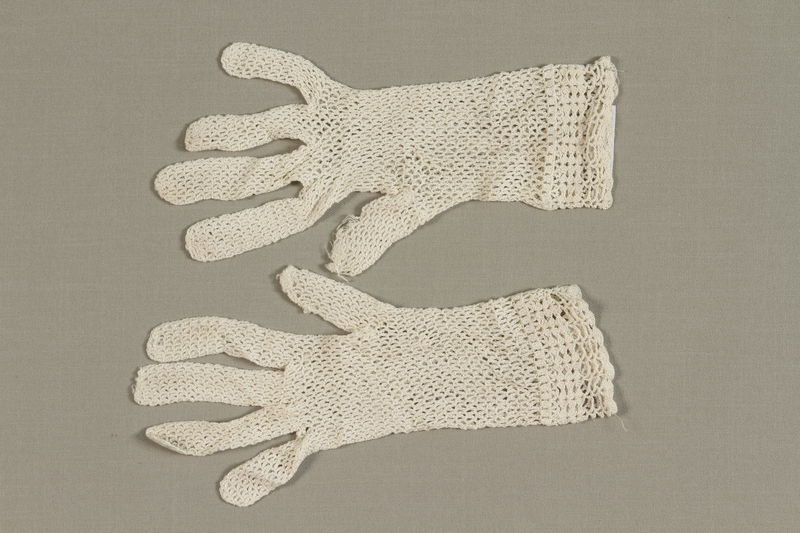Overview
- Brief Narrative
- White lace gloves crocheted by Saartje Nathans while she lived in hiding in the home of Aaltje and Paul Paulus in Ermelo, Netherlands, from October 1942-April 1945. She made over forty pairs of gloves, which the Paulus family used as gifts. In 1942, after nearly two years of occupation by the Germans, deportations were becoming frequent. Saartje and Michel decided to send their two year old daughter, Anita, to live with a non-Jewish family in the countryside. That October, they left Amsterdam and were offered a hiding place with the Paulus family. They lived all day in a small attic bedroom; Paul built a hidden compartment in the room when the Germans intensified their searches for hidden Jews. Paul built three other hiding spaces: a dugout under the kitchen floor, and two deep holes outside in the nearby woods. Paul played a leadership role in the resistance in the area and the hiding spaces were used often. On April 18, 1945, Ermelo was liberated by British, Irish, and Canadian forces. Saartje and Michel reunited with Anita and returned to Amsterdam.
- Date
-
creation:
1942 October-1945 April 18
- Geography
-
creation:
Ermelo (Netherlands)
- Credit Line
- United States Holocaust Memorial Museum Collection, Gift of the family of Alice and Paul Paulus
- Contributor
-
Artist:
Selly Nathans
Subject: Selly Nathans
Subject: Paul Paulus
- Biography
-
Saartje (Selly) Regina Goldsteen was born on December 16, 1910, in Meppel, Netherlands, to Jewish parents, Hartog Simon, born on January 28, 1879, and Stientje Jacobson Goldsteen, born on April 3, 1881. She married Michel Nathans, a business owner, on July 1, 1936, in Amsterdam, Netherlands. On May 10, 1940, Germany occupied the Netherlands. That year, Saartje gave birth to a daughter, Anita. In July 1942, the German authorities began deporting Dutch Jews to extermination camps in occupied Poland. Michel and Saartje decided to go into hiding. They arranged to send two year old Anita, who was deaf, to live with a non-Jewish family in the countryside while they sought a safe place for themselves. One evening, their doorbell rang three short rings, which normally announced friends or family. Instead, they found German soldiers at the door. One asked if Jews resided there and for their identification. Another searched the house and said that they should arrest everyone. Michel showed an officer their identification and his business ownership papers. After this, the soldiers left because the business papers exempted them from deportation at this time. Michel and Saartje sent their parents to a rest home for the elderly because these homes were not searched. The couple obtained false names and identification cards from the Dutch resistance for the identities Hendrik Gerrit Waterland and Anna Degenhard. After much difficulty, they received an address for a temporary home in Ermelo, Netherlands. In October, they removed their yellow Star of David badges and went to the train station to go to Ermelo.
Upon arrival, they were approached by a man on a bicycle who motioned for them to follow. They were taken to the home of a Christian family, Aaltje (Alice) and Paul Paulus, and their five month old daughter, Ineke. Paul was active in the resistance movement, and their home was a way station for Jews seeking refuge. Michel and Saartje lived all day in a small upstairs bedroom to keep their existence a secret. They occupied their time by exercising, reading, playing cards, and doing puzzles or chores. Saartje mended the family’s clothes and crocheted forty pairs of lace gloves that were used as gifts. Michel made wooden tie racks, which Paul then sold. They spent most evenings downstairs with the Paulus family, listened to the progress of the war on a hidden radio, sharing stories, or reading the Bible. Sometimes, Paul put wet clothes over the stove to steam up the windows, so they could be downstairs during the day.
Michel and Saartje soon learned that her parents, brothers, and sister-in-law had been deported to Poland via Westerbork transit camp. In April 1943, they learned that the war most likely would not end until early 1945. The couple learned that Michel’s father had died in Westerbork and his mother had been deported to Poland. One evening, they were warned by a Paulus family relative that the German police had arrived in Ermelo and planned to go door to door looking for Jews. Paul constructed a hiding place behind the upstairs bedroom wall for Michel and Saartje. On December 16, Saartje’s birthday, Paul arranged for Anita to visit her parents. They had not seen her in over a year.
On January 7, 1944, Aaltje gave birth to a son, Paul Bernard. The war made resources scarce and the gas and electricity were shut off. In early 1944, Michel and Paul occasionally went out after dark to take firewood from a German stockpile across the street. Paul’s brother, Keimpe, refused to report for a work detail in Germany, and the resistance informed him that the Germans planned to burn down his house. The Jewish couple he was hiding in his home was sent to Paul’s where they shared a room with Michel and Saartje for two weeks. Paul and one of his brothers dug out a small crawl space under the kitchen floor for Michel and Saartje to sleep at night. They put down a mattress and blankets. It was accessed by a wooden trap door that was concealed by a rug and the kitchen table.
In September 1944, the southern Netherlands was liberated, but the northern region, which included Ermelo, remained occupied. On April 18, 1945, British, Irish, and Canadian troops liberated Ermelo. Aaltje and Paul did not learn Michel and Saartje’s real names until after the war. The couple stayed with them for a few months then reunited with their daughter and returned to Amsterdam.
Seventy of Michel and Saartje’s relatives perished in concentration camps. They had a son, Harry, after the war. The families remained in close contact. In 1957, the Paulus family emigrated to the United States. Saartje passed away, age 64, on August 2, 1975. In 1987, Paul and Aaltje were recognized as Righteous Among the Nations by Yad Vashem. Michel passed away, age 96, on February 19, 2002.
Paul Paulus was born on April 29, 1916. He married Aaltje (Alice) Rijskamp, who was born on February 20, 1915, in Stedum, Netherlands. They settled in Ermelo. On May 10, 1940, the Germans occupied the Netherlands, and on May 14, the Dutch Army surrendered. Paul became involved with the Dutch resistance movement. He tried to work for the resistance in England, but the coast already had been occupied by the Germans. Aaltje gave birth to a daughter, Ineke, in May 1942.
In summer 1942, the German authorities began deporting Dutch Jews to extermination camps. The town doctor, Dr. Holtrop, was active in the resistance and asked Paul and Aaltje to shelter Jews in need of temporary way stations as they awaited more permanent locations. The first person to stay with them was an elderly Jewish man from Amsterdam who insisted upon taking daily walks through the village. This attracted attention and people asked the Paulus’s if their guest was a Jew. After a month, he was moved to another hiding place.
A few other people stayed briefly in their home. In October, Paul and Aaltje gave refuge to a young Jewish couple, Michel and Saartje (Selly) Nathans, from Amsterdam. The resistance had provided them with new names and identification cards. The couple had sent their two year old daughter, Anita, who was deaf, to live with a non-Jewish family in a different home. They did not wish to move elsewhere. After the two couples talked, the Paulus’s invited them to stay longer. To keep their existence secret, Michel and Saartje stayed all day in a small upstairs bedroom. Michel made small wooden tie racks, which Paul then sold. Saartje mended the family’s clothes and crocheted gloves. The couples spent evenings downstairs together sharing stories, listening to the progress of the war on a hidden radio, or reading the Bible. Paul sometimes put wet clothes over the stove to steam up the windows, so Michel and Saartje sometimes could be downstairs during the day, carefully avoiding windows.
One evening in 1943, they were warned by one of Paul’s relatives that the German police had arrived in Ermelo and planned to go door to door looking for Jews. Paul constructed a hiding place behind the upstairs bedroom wall for Michel and Saartje. On December 16, Saartje’s birthday, he arranged for Anita to visit her parents. They had not seen her in over a year. On January 7, 1944, Aaltje gave birth to a son, Paul Bernard. As the war continued, resources became scarce and the gas and electricity were shut off. They cut down trees in the nearby forest and used doors and furniture for firewood to keep warm. In early 1944, Paul and Michel occasionally went out after dark to take firewood from a German stockpile across the street. They used candles at night, but when this supply dwindled, they used oil soaked rags. Food supplies were meager. Aaltje’s sister and her husband lived in Groningen and came by train every month with suitcases filled with potatoes, flour, peas, and bacon. They got vegetables from a neighbor’s garden and bought grain from the nearby farmers to bake bread.
In 1944, Paul and one of his brothers dug out a small crawl space under the kitchen floor for Michel and Saartje to sleep at night. They put down straw, a mattress, and blankets. It was accessed by a wooden trap door that was concealed by a rug and the kitchen table. Paul also dug two holes in the wooded area outside the house to be used a hiding places. They were deep enough to hide several people and were covered with wood slats, grass, leaves, and tree branches. They were used often to hide Jews, as well as resistance members, including Paul, because of his leadership role in the resistance. One night, the families heard boots and voices outside. Michel and Saartje hid under the trap door. Aaltje prayed and answered the door to four armed German soldiers in need of directions.
German authorities ordered Paul’s brother, Keimpe, to report for a work detail in Germany. He refused, and they threatened to burn down his house. The Jewish couple who were living in hiding in Keimpe’s house was sent to Paul’s house where, for two weeks, they shared a room with Michel and Saartje. Aaltje’s brother, Jan, refused to report for military duty. He was sent to a labor camp in the Netherlands then deported to a concentration camp in Germany. He escaped, and walked back to the Netherlands. Many resistance members and rescuers were caught and sent to concentration camps or killed, but Paul and Aaltje continued to take in people. The resistance eventually infiltrated the local police force, which allowed them to find out about impending raids. On September 17, 1944, Allied airborne operations began in their province. The southern Netherlands was liberated, but the northern region, which included Ermelo, remained occupied. In winter 1944-1945, they suffered a terrible famine because of the German blockade. On April 18, 1945, British, Irish, and Canadian forces liberated Ermelo. Aaltje and Paul did not learn Michel and Saartje’s real names until after the war. The couple stayed with them for a few months then reunited with their daughter and returned to Amsterdam. Seventy of Michel and Saartje’s relatives, many Dutch citzens, perished in concentration camps during the Holocaust. Aaltje and Paul had another daughter, Anneke, after the war. The families remained close. In 1956, the United States offered immigration opportunities to those involved in the resistance, and the Paulus family emigrated to the US the following year. They settled in Westerville, Ohio. Aaltje spoke often of their wartime experiences to civic groups. Paul passed away, age 64, on March 17, 1981. In 1987, Paul and Aaltje were recognized as Righteous Among the Nations by Yad Vashem. Aaltje passed away, age 84, on March 3, 1999.
Physical Details
- Classification
-
Dress Accessories
- Category
-
Handwear
- Object Type
-
Gloves (lcsh)
- Physical Description
- a. White crocheted lace left hand glove handmade from high sheen, fine cotton thread. The body has a plain openwork pattern with rounded fingers. The wrist cuff has a horizontal pattern of solid stitches, then larger openwork stitches with a scalloped edge.
b. White crocheted lace right hand glove handmade from high sheen, fine cotton thread. The body has a plain openwork pattern with rounded fingers. The wrist cuff has a horizontal pattern of solid stitches, then larger openwork stitches with a scalloped edge. There is a break in the lace on the inner thumb. - Dimensions
- a: Height: 8.625 inches (21.908 cm) | Width: 4.125 inches (10.477 cm) | Depth: 0.125 inches (0.318 cm)
b: Height: 8.875 inches (22.543 cm) | Width: 3.750 inches (9.525 cm) | Depth: 0.125 inches (0.318 cm) - Materials
- a : thread
b : thread
Rights & Restrictions
- Conditions on Access
- No restrictions on access
- Conditions on Use
- No restrictions on use
Keywords & Subjects
Administrative Notes
- Legal Status
- Permanent Collection
- Provenance
- The white lace gloves were donated to the United States Holocaust Memorial Museum in 2010 by Paul B. Paulus, the son of Alice and Paul Paulus.
- Funding Note
- The cataloging of this artifact has been supported by a grant from the Conference on Jewish Material Claims Against Germany.
- Record last modified:
- 2022-07-28 21:51:11
- This page:
- https://collections.ushmm.org/search/catalog/irn43415
Also in Alice and Paul Paulus collection
The collection consists of artifacts, correspondence, documents, oral histories, and photographs relating to the experiences of Aaltje (Alice) and Paul Paulus and Michel and Saartje (Selly) Nathans, who lived in hiding in the Paulus’ home, in Ermelo, Netherlands, during and after the Holocaust.
Date: 1939 September-2002 June

Ordedienst orange armband worn by a Dutch rescuer after the war
Object
Ordedienst [Order Service] armband issued in Harderwijk, Netherlands, and worn by Paul Paulus after liberation in April 1945. It identified Paul as an official civilian authority. During the German occupation of the Netherlands, May 1940-April 1945, Paul and his wife, Aaltje, who lived in Ermelo, aided resistance efforts by hiding Jews in their home. In October 1942, they gave refuge to a Jewish couple, Michel and Saartje Nathans, from Amsterdam, whose young daughter, Anita, was hidden in a different home. Paul built a hidden chamber in the attic bedroom where Michel and Saartje stayed. He built three other hiding places: a dugout under their kitchen floor and two deep holes outside in the nearby woods. Paul played a leadership role for the resistance in his area and the hideouts were used frequently. On April 18, 1945, Ermelo was liberated by British, Irish, and Canadian forces. Michel and Saartje reunited with Anita and returned to Amsterdam.

Red wooden tie rack made by a Dutch Jew while living in hiding
Object
Small wooden tie rack constructed by Michel Nathans while he lived in hiding in the home of Aaltje and Paul Paulus in Ermelo, Netherlands, from October 1942-April 1945. The tie racks he made were then sold by Paul. In 1942, after nearly two years of occupation by the Germans, deportations were becoming frequent. Michel and Saartje decided to send their two year old daughter, Anita, to live with a non-Jewish family in the countryside. That October, they left Amsterdam and were offered a hiding place with the Paulus family. They lived all day in a small attic bedroom; Paul built a hidden compartment in the room when the Germans intensified their searches for hidden Jews. Paul built three other hiding spaces: a dugout under the kitchen floor, and two deep holes outside in the nearby woods. Paul played a leadership role in the resistance in the area and the hiding spaces were used often. On April 18, 1945, Ermelo was liberated by British, Irish, and Canadian forces. Saartje and Michel reunited with Anita and returned to Amsterdam.
Paul and Alice Paulus papers
Document
Collection of papers, correspondence, and photographs that document the experiences of the Paulus family who hid members of the Nathan family and others in their home in Ermelo, The Netherlands during the Holocaust.

Oral history interview with Alice Paulus and Michel Nathan
Oral History
Alice Paulus discusses the experiences of her family who hid members of the Nathan family and others in their home in Ermelo, The Netherlands during the Holocaust. In the second video segment, Alice Paulus and Michel Nathan discuss their wartime experiences together.




